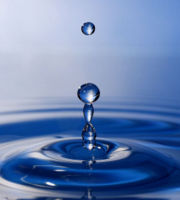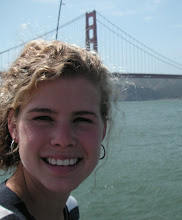Test Strips 1-4

These four test strips show the print at different apertures. The first test strip is too evenly grey so that the print would seem flat. The second, although way too light to be representative of how it could look still show one shade of grey without definition or promise that the dark places will become defined. No contrast. The third test strip is similar. Although the time seems right, the skin is a greyish color and the parts that should be bolder and more defined are not. Finally, when I tried an aperture of 5.6, the results were much better. Now the collar is a darker, but not at the expense of the skin becoming dark and ashy. Also there is more of a noticable differece between the different intervals as the shades get continually more contrasted rather than simply darkening existing grey shades. Lastly there are bold lines around the eyes and especially the eyebrows that define the face and make it less wishywashy.
Final Print

The final print came out fine. While I usually prefer a darker, bolder print, in this case it somewhat fits to have a lighter print to go with Ryan's personality. His hair is nicely highlighted in the sun in some places and his sweater helps to balance out the image by making it darker and grounding it. I kind of like that his eyes cannot be seen.
Print Two: Two Subjects: Alan and Claudio
I was excited about this print because it presents these two guys just being as they are: both laughing and joking and it's a pretty fun print. Though it did come out a bit dark.
Test Strip 1

This test strip shows a good richness of color around the 8 second range. I think that that aperture is correct (it was taken in the same conditions as the previous one anyways so that would make sense) it is just a matter of finding what time suits Alan, as this focuses only on Claudio.
Test Strip 2>

So the next test strip was done at 8 seconds to see if this worked on Alan's par t of the photo. I think that it was successful as you can see detail in his face, and his hair is dark enough with a few light spots (from the sun?), and his teeth and eyes are light enough. So I decided to proceed with the final print.
Final Print

Somehow the final print came out darker than these two test strips. I reprinted at a later date to get more visibility on the faces of the two as they were too dark. This worked out better than I thought, because their hair still remained a dark shade instead of lightening up and turnign a dark grey like I thought it might. This is the first version, however. It is a shame that I scratched the negative, as the scrape on the front is very noticable and bugs me. Also, from close up there are other specks of white bits that could be done without.
Print Three: Close up: Katrine
This one was by far the easiest print. After trying for a while unsuccessfully to get a print of Anthony to work out, I tried this one at the same settings as the one before and it worked immediately.
Test Strip One

The test strip shows some promising things. Katrine's eyes are really dark, yet her skin is not to0 dark. The most important thing to notice, however, is the hair, since that is the focus of the picture. I was really pleased with how you can see the detail of her hair as far as texture and shading. It looks very shiny and the differences in color make for a very interesting look. I couldn't tell all this from the contact sheet so it is a good thing that I tried it.
Final Print

So I tried a final print to see if it looked okay for the rest of it. I think that it worked out nicely. Although I am not wild about the composition, I think that it is flattering to her waves and shows that she has neat hair. I also think that it is a balanced photo, as the background is very dark and surrounds her on all sides. Also, the contrast is good, but I hope that it is not too overdone.












